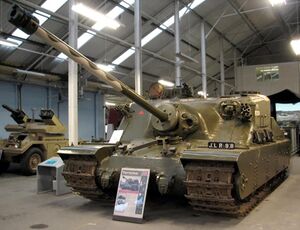Engineering:Ordnance QF 32-pounder
| Ordnance QF 32-pounder | |
|---|---|
 The 32-pdr mounted in the Assault Tank A39 Tortoise | |
| Type | Gun |
| Place of origin | United Kingdom |
| Service history | |
| Used by | British |
| Wars | Second World War |
| Specifications | |
| Mass | 2,972 kg (6,552 lb) |
| Calibre | 94 mm |
| Muzzle velocity | 2,880 feet per second (880 m/s) |
| Effective firing range | 1,230 metres (1,350 yd) |
The Ordnance QF 32 pounder or (32-pdr) was a British 94 mm gun, developed as a replacement for the Ordnance QF 17 pounder (17-pdr) anti tank and tank gun.
Like the German 88 mm gun it was developed from an anti-aircraft (AA) gun, in this case the QF 3.7 inch AA gun.
Developed during the Second World War, the gun was used in the experimental Tortoise heavy tank. At least one 32-pdr was developed as an anti-tank gun on a wheeled carriage and a single example using a novel form of muzzle brake was installed in a de Haviland Mosquito as an up-gunned version of the 'Tsetse' Mosquito FB MkXVIII (instead of the 57 mm Molins gun). While flight trials did not take place until after the war, the aircraft flew and the gun fired without problems.[1]
The 32-pdr fired a 32 lb armour-piercing shot at a muzzle velocity of 2,880 ft/s (877.8 m/s).
The 32 pdr sabot (APDS) Mk.3 shell could penetrate 200mm/50° RHA (LOS 311mm) at 100 yards during the test in 1946, which meant that its penetration was even far more than many early APFSDS. Meantime, M308 HVAP (used in 90mm M3 tank gun) could only penetrate 114mm/50° at 100 yards.
Development was halted with the end of the war, and the 17-pdr was replaced with the 20-pdr for tank use and with the intention to develop guided weapons for infantry use.
See also
- British standard ordnance weights and measurements
References
- ↑ New Vanguard 98: British Anti-Tank Artillery 1939-45. by Chris Henry. Osprey Publishing
- Allied Secret Weapons a Purnell's History of the World Wars Special. Phoebus, 1975, (No ISBN)

